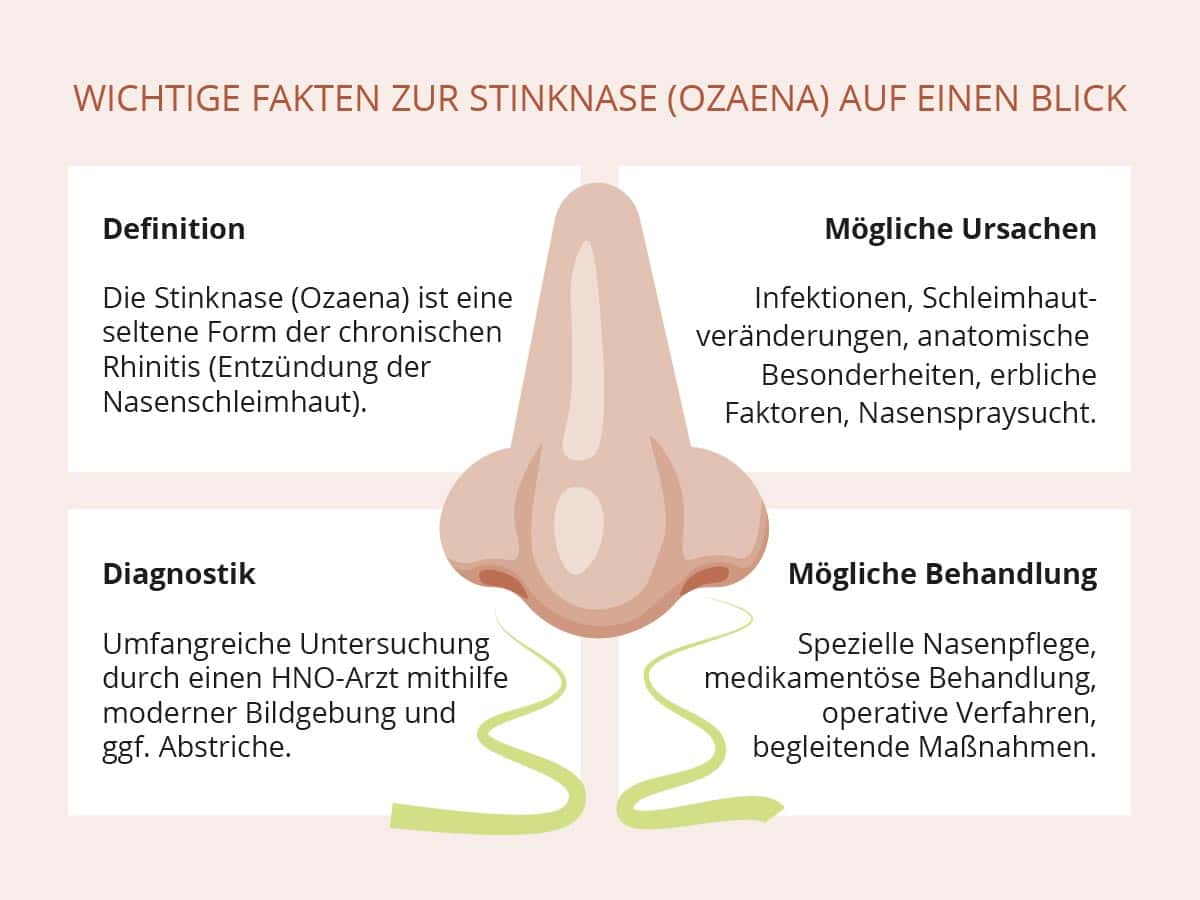
04 Sep Stinky nose: When Ozaena determines life
An unpleasant odour from the nose is usually first noticed by those around you and causes irritation. For those affected, however, it is often barely noticeable because the disease is associated with a reduced sense of smell. This symptom is often caused by a chronic disease of the nasal mucosa, known as stinky nose or ozaena. It changes the mucous membrane permanently and affects far more than just breathing. A closer look at the causes, typical signs and consequences helps to better understand the disease and find ways to achieve noticeable treatment success.
What is a stinky nose?
Stinky nose - technically known as ozaena - is a rare form of chronic rhinitis. It is a persistent inflammation of the nasal mucosa that persists over a long period of time and does not resolve on its own like a normal cold. As a result of this permanent irritation, the mucous membrane dries out considerably and produces less secretion. As a result, dead mucosal cells and bacterial residues thicken to form thick, greenish-brown crusts. These crusts release an intense, unpleasant foul-sweet odour.
Important to know: A stinky nose does not develop overnight, but develops slowly over months or even years.
Causes of ozaena: how a stinky nose develops
Several influences can lead to a chronic inflammation of the nose turning into a stinky nose. Some people are more susceptible due to the condition of their mucous membranes, while infections or hereditary factors play a role in others. Several causes often interact and together trigger the typical changes inside the nose. Possible triggers are, for example
Chronic infections
Recurrent infections of the nose can severely weaken the mucous membrane. In many cases, the bacterium Klebsiella ozaenae is involved. It belongs to the so-called gram-negative germs. This refers to bacteria that have a special cell wall structure and are therefore often more resistant to certain antibiotics.
Klebsiella ozaenae is not uncommon in the nose and throat. However, if the mucous membrane is damaged or dried out, the bacterium can multiply rapidly and exacerbate the inflammation.
Over time, the mucous membrane regresses and the nasal cavity expands. These changes pave the way for new infections - a vicious circle that favours the typical changes of a stinky nose.
Changes in the mucous membrane
Some people naturally have a more sensitive nasal mucosa, which produces less secretion and dries out more quickly. This is comparable to the dry skin type, which is characterised by a lack of moisture and too little sebum production. As a result, the skin is also rough and flaky.
In addition, the mucous membrane can lose its protective and barrier function over the course of a lifetime - e.g. due to frequent infections, environmental stress or operations. Metabolic diseases such as diabetes, hormonal changes during the menopause and certain deficiencies can also affect the condition of the nasal mucosa.
Without sufficient moisturisation, fine injuries occur that pave the way for inflammation. In the long term, the tissue retracts and the nasal cavity widens. These changes significantly favour the development of a stinky nose.
Nasal spray addiction
Excessive and long-term use of decongestant nasal sprays can cause considerable damage to the nasal mucosa. The constant constriction of the blood vessels causes the tissue to dry out, lose its resistance and become more susceptible to inflammation. In the long term, such changes favour the development of a stinky nose
You can find out more about this in our blog post: Nasal spray addiction: What are the consequences?
Special anatomical features
The shape and condition of the nasal cavity can also play a role. Some people have naturally wide nasal passages in which the air flows too quickly and the mucous membrane dries out more.
In other cases, changes only occur in the course of life. After operations (e.g. when Reduced turbinates or after accidents, it can happen that parts of the nasal mucosa or turbinates are permanently damaged. However, the turbinates are important because they moisturise, warm and filter the inhaled air.
If they recede too much, the nasal cavity becomes unnaturally wide. This allows air to flow through unchecked and the mucous membrane dries out more quickly. As a result, the natural protective function of the nose is lost. It is precisely these conditions that favour the development of ozaena.
Hereditary factors
Stinky nose occurs more frequently in some families, which indicates a genetic predisposition. Presumably, both the sensitivity of the nasal mucosa and the tendency to infections are inherited. As a result, several family members may develop similar problems with dehydration, crust formation or recurring infections.
Even if the exact genes have not yet been identified, the following applies: anyone with a family history may have an increased risk of developing stinky nose.
What are the consequences of a stinky nose?
Oceana affects far more than just the mucous membrane of the nose. The changes inside the nose affect breathing, sense of smell and general well-being. In addition, there are symptoms that can affect everyday life and sometimes also put a strain on the social environment. Typical consequences of a stinky nose are
- Crust formation and dehydration
Thick, foul-smelling crusts form in the nose, which are difficult to remove and feel unpleasant. - Olfactory disorder (anosmia or hyposmia)
Many sufferers lose some or all of their sense of smell. As a result, they often do not even notice the typical odour themselves. - Obstructed nasal breathing
The crusts and the altered mucous membrane make it difficult to breathe through the nose. Some patients are therefore permanently dependent on mouth breathing. - Frequent infections
The damaged mucous membrane can no longer fulfil its defence function properly. This makes it easier for bacteria to colonise and exacerbate the existing symptoms. - Poor quality of sleep
Obstructed nasal breathing can Snoringdry mouth and an overall restless sleep. - Psychosocial stress
Because the odour is perceived from the outside, those affected often feel stigmatised and react with social withdrawal.
How the diagnosis of ozaena works
If you recognise yourself in the symptoms mentioned here, a visit to our ENT clinic in Frankfurt makes sense. Firstly, we will have a detailed discussion about your symptoms. The duration, strength of the odour and possible pre-existing conditions play an important role here.
This is followed by a thorough examination of the nose, usually using a nasal mirror and ENT endoscopy. The typical changes such as crusts, an enlarged nasal cavity and receding turbinates can be recognised directly. We can also take swabs from the nasal mucosa to detect bacteria such as Klebsiella ozaenae.
In some cases, additional procedures such as an olfactory test or imaging examinations (e.g. CT of the paranasal sinuses) are used. This allows us to assess how badly your mucous membrane is damaged and whether there may be other causes.
Differential diagnoses: Which diseases must be excluded
Not every unpleasant odour from the nose automatically means a stinky nose. Similar symptoms can also occur with other illnesses. These include, for example
Chronic sinusitis (inflammation of the paranasal sinuses)
With a long-lasting inflammation of the paranasal sinuses purulent secretions accumulate and flow out through the nose. This secretion can cause an unpleasant odour that sometimes resembles that of a stinky nose.
In addition, those affected often suffer from pressure pain in the face, blocked nose and an impaired sense of smell. Through a thorough examination, often supplemented by imaging procedures, we can distinguish chronic sinusitis from ozaena.
Foreign body in the nose
It is not uncommon for children to push small objects into their nose while playing, which then remain there unnoticed. This irritates the mucous membrane and causes an inflammatory reaction.
This can result in a foul-smelling, often purulent discharge, which initially occurs on one side. This finding is an important indication for us, as a stinky nose usually affects both sides of the nose. We can recognise and remove the foreign body with a simple examination using a nasal mirror.
Certain tumours of the nasal cavity or paranasal sinuses
Benign or malignant Tumours in the nose and the neighbouring sinuses can cause symptoms similar to a stinky nose. These include foul-smelling discharge, crust formation or changes in the sense of smell.
Other symptoms often occur in addition, such as recurring Nasal haemorrhagesa one-sided nasal congestion or pain in the facial area.
As these signs can initially be unspecific, a precise examination is crucial. With the help of modern imaging and, if necessary, tissue samples, it is possible to clarify whether a tumour is the cause of the symptoms.
Can a stinky nose be treated?
Stinky nose is considered a chronic disease - yet there are effective ways to treat its symptoms. With the appropriate therapy, the mucous membrane can be stabilised and the Improve nasal breathing. With consistent care, the unpleasant odour can often be significantly reduced. The following approaches are possible:
Specialised nasal care
Daily care of the nose plays a central role in the treatment of ozaena. Rinsing with saline solutions (so-called Nasal showers) help to gently loosen stuck crusts and rinse out germs.
Special nasal oils or ointments provide the mucous membrane with additional moisture, prevent it from drying out again and help to reduce the typical odour. This consistent care helps to stabilise the nasal environment.
Drug treatment
If the nose is heavily colonised with bacteria, special antibiotics can help to reduce the germs and alleviate acute symptoms.
Vitamin supplements or regenerating agents that strengthen the mucous membrane can also be used. This makes the tissue more resistant and reduces the risk of recurring infections.
Surgical procedures
In severe cases, it may be useful to narrow the nasal cavity in order to normalise the airflow and protect the mucous membrane.
Accompanying measures
Air humidification, avoidance of irritants and good general health care support the success of the treatment.
Used consistently, the therapy alleviates the symptoms and prevents the cycle of dehydration, crust formation and bacterial colonisation from continuing.

Expert help with the diagnosis and treatment of a stinky nose: your ENT practice clinic Goethe10 in Frankfurt
Ozaena is a stressful and often protracted illness for those affected, which does not resolve on its own without targeted therapy.
At our Goethe10 ENT practice clinic in Frankfurt, you will find a specialised team that carefully clarifies the causes and uses modern treatment methods. You will receive comprehensive care - from the initial examination to long-term support - and therefore the best possible support on the way to a better quality of life.
Simply contact us to arrange an appointment!
Do you have any questions on this topic or would you like to arrange a consultation?
ENT Frankfurt: Dr Thomas Fischer & Dr Albrecht Linke
Your specialists for ear, nose and throat medicine, who will provide you with professional and individualised advice, examinations and treatment in all matters relating to ENT medicine, functional plastic surgery and the aesthetic treatment of changes to the facial skin.
Our news articles are prepared for you to the best of our knowledge and belief and are intended for general education. They are in no way a substitute for medical advice, diagnosis and treatment and are not intended to encourage self-diagnosis or self-treatment. Please always contact your ENT specialist in Frankfurt directly if you have any health complaints!
© "Bad smelling, deodorant asian young woman hand squeeze, covering nose smell stink, breathing smelly disgust strong, expression face dislike odor, smelly armpit underarm. Medical health, skin body care" by KMPZZZ, stock.adobe.com
© "Set of five cartoon noses featuring different shapes ideal for art, learning, or design tasks. " by Богдан Скрипник

